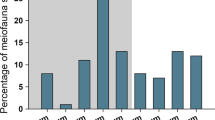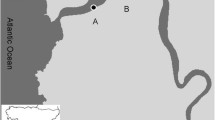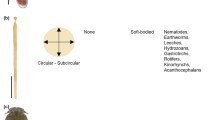Abstract
Studies in the coastal area of Bohai Bay, China, from July 2006 to October 2007, suggest that the method of meiofaunal biomass estimation affected the meiofaunal analysis. Conventional estimation methods that use a unique mean individual weight value for nematodes to calculate total biomass may cause deviation of the results. A modified estimation method, named the Subsection Count Method (SCM), was also used to calculate meiofaunal biomass. This entails only a slight increase in workload but generates results of greater accuracy. Results gained using each of these two methods were compared in the present study. The results show that the conventional method generally estimates a meiofaunal biomass. The difference between the two estimation methods was highly significant (P<0.01) for the spring and winter cruises. Furthermore, the estimation method for meiofaunal biomass affected the analysis of horizontal distribution and correlation with environmental factors. These findings highlight the importance of estimation methods for meiofaunal biomass and will hopefully stimulate further investigation and discussion of the topic.
Similar content being viewed by others
References
Bradshaw C, Kumblad L, Fagrell A. 2006. The use of tracers to evaluate the importance of bioturbation in remobilising contaminants in Baltic sediments. Estuarine, Coastal and Shelf Science, 6: 123–134.
Chinese Technology, Supervise Bureau (CTSB). 1991. The Specification for Oceanographic Survey. Standard Press of China, Beijing, China. p. 26–29. (in Chinese)
Danovaro R, Tselepides A, Otegui A, Norberto D C. 2000. Dynamics of meiofaunal assemblages on the continental shelf and deep-sea sediments of the Cretan Sea (NE Mediterranean): relationships with seasonal changes in food supply. Progress in Oceanpgraphy, 46: 367–400.
Girer O. 1993. Meiobenthology, the Microscopic Fauna in Aquatic Sediments. Springer-Verlag. p. 1–40.
Guo Y Q, Zhang Z N, Mu F H. 2002a. Biomass of meiofauna in the Bohai Sea, China. Acta Oceanologica Sinica, 24: 76–83. (in Chinese)
Guo Y Q, Zhang Z N, Mu F H. 2002b. Large-scale patterns of meiofaunal abundance in the Bohai Sea. Acta Ecologica Sinica, 22: l 463–1 469. (in Chinese)
Gyedu-Ababio T K, Baird D. 2006. Response of meiofauna and nematode communities to increased levels of contaminants in a laboratory microcosm experiment. Ecotoxicology and Environmental Safety, 63: 443–450.
Liu X S, Zhang Z N, Huang Y. 2005. Abundance and biomass of meiobenthos in the spawning ground of anchovy (Engraulis japanicus) in the southern Huanghai Sea. Acta Oceanologica Sinica, 24: 94–104.
Montagna P A, Bauer J E, Hardin D. 1995. Meiofaunal and microbial trophic interactions in a natural submarine hydrocarbon seep. Vie Milieu, 45: l7–25.
Mu F H, Zhang Z N, Guo Y Q. 2001. Abundance and biomass of the benthic meiofauna in the Bohai Sea. Journal of Ocean University of Qingdao, 30(6): 897–905. (in Chinese)
Nozais C, Perissinotto R, Tita G. 2005. Seasonal dynamics of meiofauna in a South African temporarily open/closed estuary (Mdloti Estuary, Indian Ocean). Estuarine, Coastal and Shelf Science, 62: 325–338.
Raghukumar C, Bharathi P A, Ansari Z A. 2001. Bacterial standing stock, meiofauna and sediment-nutrient characteristics: indicators of benthic disturbance in the Central Indian Basin. Deep-sea Research II, 48: 3 381–3 399.
State Oceanic Administration (SOA). 2008. Technological Regulations for Marine Chemistry Survey. Ocean Press, Beijing, China. p. 1–192. (in Chinese)
Sutherland T F, Levings C D, Petersen S A. 2007. The use of meiofauna as an indicator of benthic organic enrichment associated with salmonid aquaculture. Marine Pollution Bulletin, 54: 1 249–1 261.
Troch D M, Gansbeke D V, Vincx M. 2006. Resource availability and meiofauna in sediment of tropical sea grass beds: Local versus global trends. Marine Environmental Research, 61: 59–73.
Urban-Malinga B, Moens T. 2006. Fate of organic matter in Arctic intertidal sediments: Is utilisation by meiofauna important? Journal of Sea Research, 56: 239–248.
Vassallo P, Fabiano M, Vezzulli L. 2006. Assessing the health of coastal marine ecosystems: A holistic approach based on sediment micro and meio-benthic measures. Ecological Indicators, 6: 525–542.
Wieser W. 1960. Benthic studies in Buzzards bay II the meiofauna. Limnology and oceanography, 5: 121–137.
Zhang Q T, Hu G K. 2008. Application of meiofauna in the marine ecological monitoring. Marine information, 198: 28–29. (in Chinese)
Zhang Q T, Wang X H, Fang E J, Ma W L, Hu G K. 2009. Studies on meiofauna abundance in offshore area of Bohai bay, Tianjin. Marine science bulletin, 28(2): 57–64. (in Chinese)
Zhang Z N, Lin K X, Zhou H. 2004. Abundance and biomass of meiobenthos in autumn and spring in the East China Sea. Acta Ecologica Sinica, 24: 997–1 005. (in Chinese)
Zhang Z N, Zhou H, Yu Z S. 2001. Abundance and biomass of the benthic meiofauna in the northern soft-bottom of the Jiaozhou Bay. Oceanologia et Limnologia Sinica, 32: l39–147. (in Chinese)
Zhang Z N, Zhou H. 2004. Some progress on the study of meiofauna. Journal of Ocean University of China, 34(5): 799–806. (in Chinese)
Author information
Authors and Affiliations
Corresponding author
Additional information
Supported by Chinese Offshore Investigation and Assessment Project (No. 908-TJ-10, 908-TJ-09) and the Initial Fund for Introduced Talent of Tianjin University of Science and Technology (No. 20090413)
Rights and permissions
About this article
Cite this article
Zhang, Q., Wang, X. & Hu, G. Evaluation of estimation methods for meiofaunal biomass from a meiofaunal survey in Bohai Bay. Chin. J. Ocean. Limnol. 28, 82–87 (2010). https://doi.org/10.1007/s00343-010-9262-4
Received:
Revised:
Published:
Issue Date:
DOI: https://doi.org/10.1007/s00343-010-9262-4




